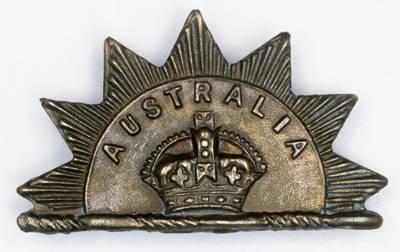Forging the Nation - Symbols
- Forging the Nation: home
- Federation
- National identity
- Seeking security
- The First World War
- Towards the future
- Australians
- Introduction
- Anzac Day
- Bushman & Digger
- Symbols
Symbols
The Commonwealth adopted formal symbols of national identity during its first twenty years. They included a flag, coat of arms, coinage, postage stamps and a seal. Both national and imperial elements found their way into the various designs.
A competition was held for the design of a flag; the winning entry combined the Southern Cross and Union Jack. The Southern Cross had featured on earlier colonial symbols and had been carried on the banner of the insurgent miners at the Eureka Stockade and on the unofficial flag of the federation movement. Five competitors submitted this design.
The Commonwealth's coat of arms, granted by Royal Warrant on 7 May 1908, had a kangaroo and emu as the supporters of a simple shield. The design did not prove popular, and in 1912 a second royal warrant approved a design in which the shield bore the six state badges and the emu stood in a more natural pose.

The federal postage stamp - the kangaroo has had sentence of death passed on him.
From The Bulletin 24 July 1913, pg 1. Collection of the Australian War Memorial.

The rising sun.
Commonwealth troops departing for the South African war in 1902 were provided with metal badges with a rising sun motif. In 1904, the rising sun design was developed to produce the famous general service badge for the Australian Army. AWM REL 25107

New currency and stamps.
The first Commonwealth silver coins appeared in 1910, followed by bronze coins a year later. The Australian £1 note was introduced in 1913. The "one-penny red" of 1912 was the first postage stamp. Unlike a stamped postcard produced a year earlier, it did not feature the portrait of the king. These replaced British coins, private bank notes, and stamps issued by the states. AWM PROP 02044

National flower.
The wattle was declared the national flower in 1912, and Wattle Day was celebrated each spring. May Gibbs, who became famous for her gumnut baby characters, Snugglepot and Cuddlepie, whose first adventures were published in 1916, drew inspiration from the flower for her Wattle Babies. AWM PROP 01898